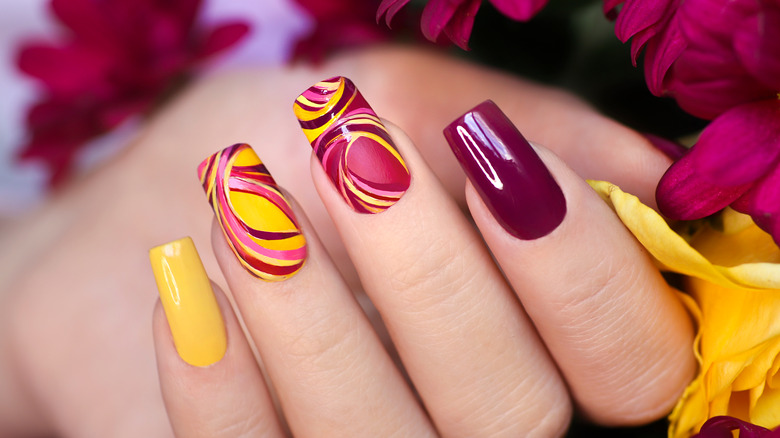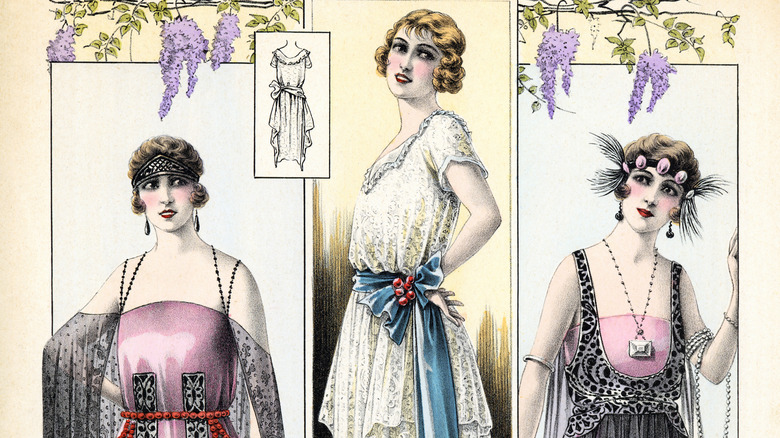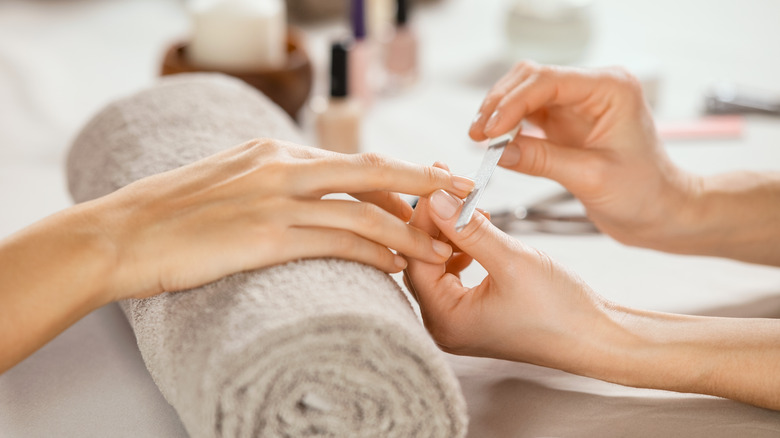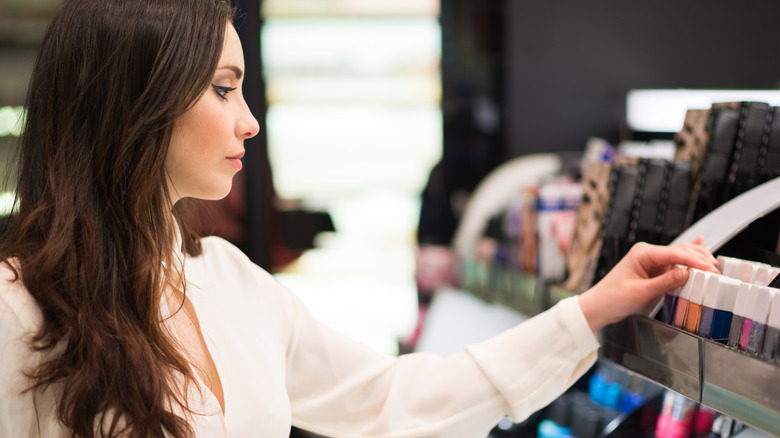A Deep Dive Into The Ancient History Of Nail Polish
Nail polish is an undeniable part of our culture. In 2020, 100.89 million people in the U.S. used nail polish or adjacent nail products, and by 2024 that number is expected to grow to 102.13 million people (via Statista). From TikTok nail trends to Instagram influencer-backed nail colors and styles, there is no shortage of ways for us to express ourselves, celebrate the season at hand, or just try something fun and different via nail polish.
But we are far from the first culture to have an obsession with painting our nails. In fact, while formulas, intentions, and cultural significance of nail color have changed and shifted over time, the very first recorded use of what we would call nail polish was in Babylonia during 3200 B.C (via Byrdie). At that time and place, warriors would color their nails before going off to battle. It is also speculated that nail colors worn by average citizens of the time indicated the social class that the person belonged to.
Interestingly, this is not the only time or place that the color of your nail polish was determined by your social rank.
Ancient nail color and its meaning
People in 3000 B.C. China also used different nail colors to display their class rank (via Byrdie). For instance, while the upper classes used things like beeswax and egg whites to color their nails subtle hues, the ruling class used more brightly pigmented shades like red. And if you were not amongst the royals and dared to wear red nail color, you could be punished severely, even by the death penalty! Talk about a fashion faux pas!
By the time of Cleopatra's Egypt, henna was being used not only to create intricate designs on people's hands, which is still a custom in several cultures today, but also to dye fingernails. Cleopatra herself is said to have used henna just for the purpose of dying her fingernails a signature blood red color.
But to understand where our current version of nail polish came from, we need to flash forward quite a bit.
Early forms of modern nail lacquer
In the late 19th century, a woman named Mary E. Cobb studied the art of nail care in France and then developed her own process for a manicure, which she later brought across the pond to the United States (via Byrdie). In fact, her nail salon, which was called "Mrs. Pray's Manicure" was the first-ever nail salon in the world, at least by the standards that the modern world would use to define a nail salon. Interestingly Cobb was also the inventor of an absolute manicure staple of the modern day: the emory board.
By the time we reached the twentieth century, nail color was making a major impact in western society, including in the United States. In 1910, a catalog from the California Perfume Company advertised a "manicuring set" that included a bleaching agent for whitening the nails, a rose-tinted pomade for tinting the nails a pinkish hue, a powder that helped to polish the nail for a healthy-looking sheen (via Hagley Library).
At the time, that was pretty much what cutting-edge cosmetic nail care looked like, but it wasn't long before things started to change.
Major brands are born
At the start of the Roaring Twenties, a makeup artist by the name of Michelle Menard was on a mission to create a nail paint that provided all the high-shine power of the paint that was being used on another major invention of the time: motor cars (via Byrdie). The product she eventually introduced to market was so popular amongst the young women of the time known as flappers, that she was able to build a whole cosmetic brand around it, which she officially launched in 1932. That brand? Revlon.
At the same time, Cutex, now known as a nail care juggernaut, was working on a big break. The company had previously only sold a single product: a cuticle softening cream, which it had released back in 1911. But in 1925, the brand launched its own liquid nail polish, which was wildly popular and was quite similar to the liquid polish we are still using today.
Modern options from gel to powder
Ever wonder how someone came up with the idea of acrylic nails? Well, like many inventions, it was happened upon quite by accident, when someone found themselves in a bind. That someone was a dentist named Dr. Frederick Slack, who, one day in 1957, broke a nail while he was working. In an attempt to make sure his broken nail didn't interfere with his job during the rest of his workday, Slack used a makeshift system of dental acrylic and a piece of aluminum foil to repair his nail (via Byrdie). The result, however, was a false nail that looked and felt so real that Slack decided to work with his brother to perfect the formula and patent it. And acrylic nails were born.
A more recent version of false nails, which is also used in a slightly different formulation to create long-lasting polish for natural nails, is gel. Gel nails were first introduced as an option for manicures back in the 1980's, and at the time, the only choice were nails made of a hard gel. Now, however, multiple softer versions of this gel are what make today's modern gel nails as well as the liquid gel polishes and the press-on gel polish stickers (via Ray Cochrane).
And the recent introduction dip-powder polish and manicures was released in the 1990's, but didn't become super popular until recently (via Byrdie). Thanks, influencers!
The push for healthier choices
Because wearing any polish or false nails means those ingredients, at least to some degree, seep into your nail beds themselves and are therefore getting into your body to some degree, there has recently been a push for more "green" and more natural options for nail polish.
While we've known for some time that the solvents and other ingredients in nail polish isn't healthy to breathe for extended periods of time, it turns out that they aren't healthy in general, either. While any polish or false nails if left on for long periods of time without a break can cause irritation, brittle nails, dry nails, peeling nails, and other topical issues, a common ingredient in liquid polish called triphenyl phosphate, or TPHP, was found in the bloodstreams of every person who painted their nails with polish containing this ingredient in a 2015 study (via Good Housekeeping).
As such, several brands began releasing liquid polish that does not contain TPHP, and which aim at being healthier, more natural options. Simply searching online for "non-toxic nail polish" will yield several options, and there are also roundup lists in magazines like Good Housekeeping that suggest some of the best options. After all, like many other industries, the public's push toward a cleaner, greener world is making waves in the nail care industry as well, for definitely for the better.





